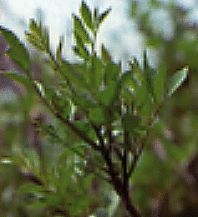Toxicodendron vernix
Poison SumacBy Roger Hilten 
photo taken by Roger Hilten
Common Names-
- poison wood
- poison tree
- poison tree
- poison weed
- poison
dogwood
- poison elder
- poison ash
- many more...
(Frankel,
1991) Identification- Leaves
-
Toxicodendron vernix branches support four alternate, pinnately
compound leaves which are lobeless and even-edged. These leaves are
arranged oppositely with a single leaf on the end of reddish leaf stalks (Eastman, 1995).
Identification problems arise since the leaves look much like those of elder,
walnut and ash. Just like these others, the leaves of poison sumac turn
bright colors in the fall (Frankel, 1991). Also, like poison ivy, the leaves of this
plant contain urishiol which causes dermatitis with blisters and vesicles (Woodward, 1985).
- Flowers-
Similar to Toxicodendron radicans, climbing
poison ivy, the flowers of poison sumac form in axillary clusters that are
sweet-smelling. - Reproduction-
Toxicodendron vernix
reproduces exactly like poison ivy in terms of pollination. That is, bees
transport the pollen of the male plant to the pistil of the female plant.
There, the pollen combines with the female's egg giving rise
to the fruit in the form of whitish drupes (Frankel, 1991). The seeds in the the drupes are then dispersed by birds (Eastman, 1995).
General Information- Toxicodendron finds a home in moist
areas, usually in swampy areas. This is the most poisonous plant species
in the U.S. (Frankel, 1991).Geography
Toxicodendron vernix L. |
| AREA | STATUS | REFERENCES |
North America:
Continental United States; Canada | Yes |
Frankel, 1991 |
Eastern North America:
United States east of Mississippi;
Ontario and eastern Canada | Yes | Frankel, 1991 |
Southeastern United States:
AL AR DE DC FL GA KY MD NC SC TN VA WV | Yes | Frankel,1991 |
Southern Appalachian States:
AL GA KY MD NC SC TN VA WV | Yes | Frankel, 1991 |
|
| Coastal Plain | Widespread | Roger Hilten, pers. ob. |
| Piedmont | Yes | Roger Hilten, pers. ob. |
| Blue Ridge Mountains | Marginal | Roger Hilten, pers. ob. |
- Great Smoky Mountains National Park
| ? | Roger Hilten, pers. ob. |
| Ridge and Valley | Yes | Roger Hilten, pers. ob. |
| Cumberland Plateau | Yes | Roger Hilten, pers. ob. |
| Central Arch | ? | Roger Hilten, pers. ob. |
|
| Georgia | Yes | Roger Hilten, pers. ob. |
| Clarke County, Georgia | Yes | UGA Herbarium Specimens |
| Sams Farm | Abundant | Roger Hilten, Pers. Ob. |
- Old Field
| No | Roger Hilten, Pers. Ob. |
- Wetland
| Abundant | - |
- Woods
| No | Roger Hilten, Pers. Ob. |
- 1-Hectare Plot
| No | Roger Hilten, Pers. Ob. |
HomeReferencesEastman, John. 1995. The Book of Swamps and Bogs. Stackpole Books. Mechanicsberg, PA. Frankel, Edward, Ph.D. 1991. Poison Ivy,
Poison Oak, Poison Sumac and their relatives; pistachios, mangoes, cashews. The Boxwood
Press. Pacific Grove, CA. (call #QK 495.A498 F73 1991). 98pages. Walters, Dirk R. 1988.
Vascular Plant Taxonomy. Kendall/Hunt. Dubuque, Iowa. (call #QK 93.W31 1988). 488 pages. Woodward,
Lucia. 1985. Poisonous Plant; A Color Field Guide. David and Charles. New York.
Toxicodendron
|